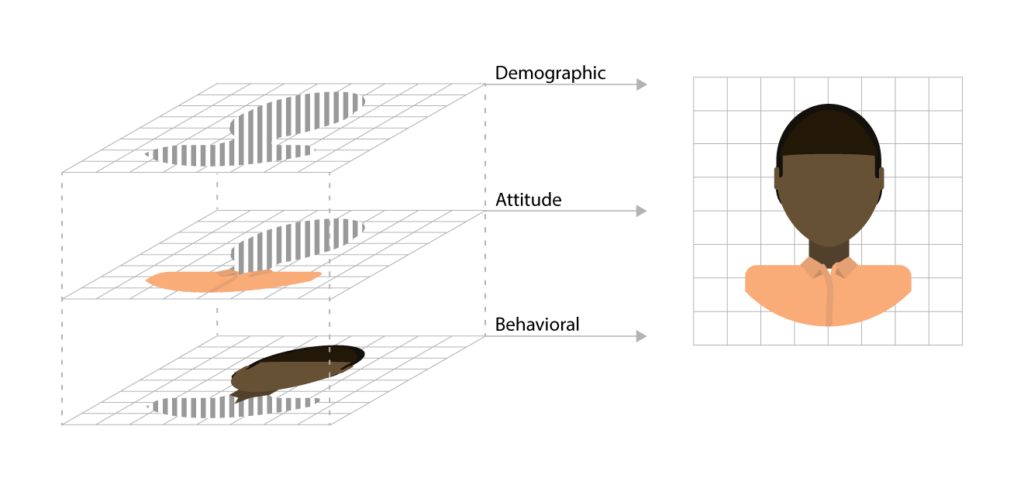Everyone has heard of “market research” as a way to learn more about the customers for a product or service, but did you know that through data-science-enhanced market research, organizations can potentially save marketing and deployment dollars in the long run? Through methods such as discrete choice modeling and segmentation, companies can ensure their longevity, sell more efficiently and maintain relevance among their competition.
So how can the experts at Fulcrum apply data science to extend the power of market research data? Keep reading to learn more.
Segmentation
Market segmentation is a means of refining a target audience, which allows organizations to deploy spending more effectively. A segmentation organizes customers and potential customers into smaller groups for marketing treatments, product development, and analysis. Having a market segmentation can answer questions such as:
- What variations of our product or service are needed to serve different segments?
- What strategies will be most effective to build loyalty across each and all segments?
- Where and with what communication will we be able to reach the right target segments for a premium product or service?

While at a basic level, segments can be defined by classifiers such as age, location, or income, a data-driven market segmentation analytically combines such demographic data with attitudinal and behavioral data to form a more holistic view of the audience. Segments are identified through statistical analyses that identify groups of people who are similar to one another in data attributes, yet different enough from other groups to be distinct. For example, there may be multiple segments of customers who behave similarly in some ways but have very different reasons for doing so.
- A high-end store may have two segments of infrequent shoppers – one that shops infrequently because they choose less expensive stores except for special occasions, and another that may love to shop at the store as much as possible but live far away.
- Another example is people who choose not to protect their homes with security systems. One segment may choose not to do this because they live in a gated community or doorman apartment building, reducing the actual risk of crime, where another segment may not feel at risk because they are always home, so are alert to all activity in the home. Yet another segment may not do so because they can’t afford or justify installing a security system, even though they feel at risk.
- One segment of dieting app or weight loss service users may be intermittent because they only use it when they want to lose weight leading up to an event or vacation, whereas a different segment of intermittent users may have a hard time with motivation and commitment and continually fall off and restart the program.
In each of these examples, treating all customers the same would only address the habits and capture the spending of some customers. Differentiated products, services, price points, and messages, when delivered at the segment-level, helps an organization to maximize its effectiveness and minimize spending by promoting the right products or messages to the right types of customers.
We approach the process of creating an analytically-derived segmentation by first collaborating with our client to design and conduct a market research survey with the target market for the product or service. We then utilize the full set of survey results plus any available demographic, behavioral, or other data appends that are available, and perform a data reduction exercise to remove highly correlated variables. Next, we utilize various statistical methods, such as latent class analysis or K-means clustering to identify the cohesive yet unique segments of consumers from the smaller set of variables. The full market research survey and body of appended data is then analyzed by looking at the differences between each segment, yielding insights into the profile, needs, habits and preferences for each segment.
Utilizing this approach allows us to identify groups of respondents through their commonalities that might not be readily observable on a cross-tabulation basis. In other words, the segments may be cohesive because of a commonly held underlying combination of needs or attitudes more than having the same demographics or purchase patterns. Segmentations are most useful when delivered along with segmentation code or logic that can be used to classify customers and prospects into the right segments within databases, future research, and in real-time interactive applications for optimal understanding, messaging, and offers well into the future.
Discrete Choice Analysis
Once an organization is aware of the different market segments for its products or services, next comes the design and pricing of the products and services. In cases where the product or service can have different versions or levels, another useful analytically enhanced market research tool is discrete choice modeling.
Through discrete choice modeling, the results of a segmentation are expounded upon to better illustrate the unique preferences and pricing sensitivities of different target markets. For organizations that offer a range of products and services at varying price points, hard data to guide decisions surrounding feature bundles and price sensitivity are imperative. Answering questions such as these can inform decisions around product development, marketing investment, pricing, and product roll out:
- Which features are additive in appeal to a basic version?
- Which features are interchangeable with equal appeal?
- How much incremental money would each segment spend for one feature versus another?
- Which combination of features bundle together for optimal purchase intent and profits for each segment?
We approach the discrete choice experiment by first collaborating with our client to create an inventory of possible features to be included in a product or service, along with a price range for each feature. Next, we formulate all possible feature combinations and price ranges of the product/service to generate a research design with an adequate number of observations for each feature and price point being tested. A market research survey is then conducted with the target market.

After the survey data is collected, we conduct discrete choice modeling to measure the market potential of each feature, identify the best combinations of features in terms of incremental lift, and calculate the price respondents are willing to pay for each feature. In some cases, competitor products/services may be included in the discrete choice experiment to factor in the power of brand to the relative market potential of each product version and pricing option. A simulator tool can be built out from the resulting dataset to estimate how market share is predicted to change with the addition or removal of features or a price change. The results of the discrete choice analysis informs either full roll-outs or limited test markets, depending on an organization’s implementation approach.
Combining Research and Data Science for Data-Derived Strategy
Market research creates value for organizations by providing direct insight into the stated needs, attitudes, and preferences of the market. By joining the insight-gathering benefits of market research with the predictive benefits of data science, the combined body of work can yield detailed intelligence to drive informed product decisions and sell more efficiently.
Smart organizations rely on solid data analysis rather than on intuition to inform decisions. To learn more about how Fulcrum’s data-driven market research can accelerate your business, contact us today.



